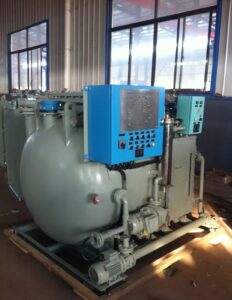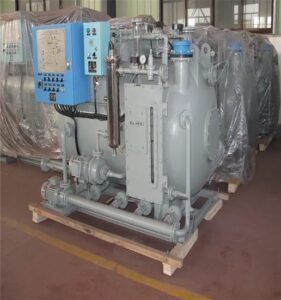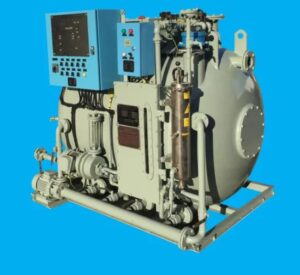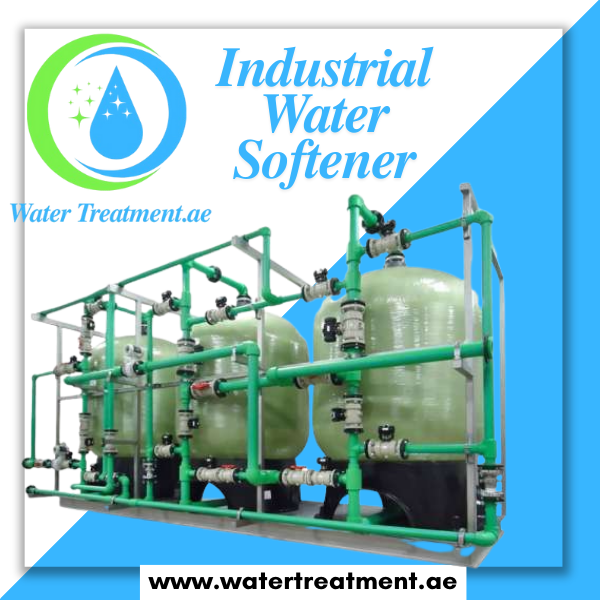Efficiently manage wastewater on marine ships with our Gray Water STP (Sewage Treatment Plant). Ensure environmental compliance and sustainability by treating gray water effectively. Choose a reliable solution for cleaner oceans and a greener marine environment.
Introduction:
Water Treatment Company UAE Gray Water Sewage Treatment Plant (STP) is designed for marine ships. It is a sophisticated solution tailored to address the unique challenges of treating gray water in maritime environments. This advanced system ensures the responsible and efficient management of wastewater generated onboard, promoting environmental sustainability and compliance with maritime regulations.


Specifications:
- Marine-Grade Construction: Engineered with materials resistant to the corrosive effects of saltwater, ensuring durability and longevity in marine environments.
- Compact Design: Space-efficient and adaptable to the confined spaces on ships, facilitating easy installation and integration into existing ship systems.
- Advanced Treatment Processes: Utilizes cutting-edge processes to treat gray water, including filtration, biological treatment, and disinfection, meeting stringent marine discharge standards.
- Automated Monitoring System: Equipped with intelligent sensors for continuous monitoring of treatment parameters, ensuring optimal performance and compliance.
- Modular Configuration: Allows for scalability and customization based on the specific needs and size of the marine vessel.
Benefits:
- Environmental Compliance: Meets and exceeds international maritime regulations for gray water discharge, contributing to environmentally responsible ship operations.
- Space and Weight Efficiency: Designed with the constraints of ship architecture, optimizing length and weight for minimal impact on vessel performance.
- Reduced Environmental Footprint: Treats and purifies gray water, minimizing the impact on marine ecosystems and promoting sustainable maritime practices.
- Reliable Operation: Ensures a consistent and reliable treatment of gray water, minimizing the risk of system failures and downtime during voyages.


Uses:
- Marine Vessels: Ideal for all types of marine vessels, including cruise ships, cargo ships, and naval vessels, providing an efficient and compliant solution for gray water treatment.
- Offshore Platforms: Applicable to offshore installations and platforms, ensuring responsible wastewater management in remote maritime locations.
- Research Vessels: Suitable for research and exploration vessels, maintaining high standards of environmental responsibility during scientific expeditions.
Frequently Asked Questions
- What is a Gray Water Sewage Treatment Plant?
- Answer: A Gray Water Sewage Treatment Plant is a system designed to treat and recycle gray water, which is wastewater generated from household activities like bathing, washing clothes, and using sinks, but not from toilets. This treated gray water can be reused for non-potable purposes, such as landscape irrigation, flushing toilets, or cooling systems. The treatment process typically involves filtration, biological treatment, and sometimes disinfection, to remove contaminants and make the water safe for reuse.
- What are the benefits of using a Gray Water Sewage Treatment Plant?
- Answer: Gray water treatment plants offer several environmental and economic benefits:
- Water conservation: By recycling gray water, less fresh water is used, reducing overall water consumption.
- Cost savings: Lower water bills due to reduced demand for potable water.
- Sustainability: Helps in reducing the strain on municipal sewage systems and water treatment facilities.
- Environmental impact: Less wastewater is sent to sewage treatment plants, lowering the risk of pollution and conserving water resources.
- Energy savings: Reduces energy consumption for water pumping and treatment.
- Answer: Gray water treatment plants offer several environmental and economic benefits:
- Is it safe to use treated gray water for irrigation or flushing toilets?
- Answer: Yes, treated gray water can be safely used for irrigation and toilet flushing when properly treated. The treatment process ensures that harmful pathogens, chemicals, and suspended solids are removed, making the water suitable for non-potable uses. However, it’s important to follow local regulations, as there may be specific standards for the quality of treated gray water for these applications. For irrigation, it’s recommended to avoid spraying treated gray water on edible plants unless it meets higher purification standards.
- What are the common treatment methods used in a Gray Water Sewage Treatment Plant?
- Answer: Gray water treatment typically involves a combination of the following methods:
- Physical filtration: To remove large particles and debris.
- Biological treatment: Using microorganisms to break down organic matter and contaminants. This can be done in a biofilter or a bioreactor.
- Chemical treatment: To neutralize harmful chemicals or disinfect the water. Chlorine or UV treatment may be used for disinfection purposes.
- Membrane filtration (optional): For finer filtration, especially in systems requiring higher water quality for reuse.
- Sedimentation: Allows solids to settle out before further treatment. Each system may vary depending on the scale, the desired end-use, and the level of treatment required.
- Answer: Gray water treatment typically involves a combination of the following methods:
- How much does it cost to install and maintain a Gray Water Sewage Treatment Plant?
- Answer: The cost of installing and maintaining a gray water treatment plant varies depending on factors like the size of the system, the treatment technology used, and the location.
- Installation costs: Small residential systems can range from $500 to $2,500, while larger systems for commercial or multi-family buildings may cost anywhere from $5,000 to $20,000 or more.
- Maintenance costs: Ongoing maintenance includes filter replacements, occasional system checks, and cleaning. Typically, maintenance costs range from $100 to $500 annually. Larger systems may incur higher operational costs, including periodic testing and disinfection procedures. The initial investment is often offset by water savings, especially in areas where water costs are high or where there is a push to conserve resources.
- Answer: The cost of installing and maintaining a gray water treatment plant varies depending on factors like the size of the system, the treatment technology used, and the location.


Conclusion:
In conclusion, the Gray Water Sewage Treatment Plant for Marine Ships represents a crucial advancement in wastewater management for maritime operations. With its specialized design, advanced treatment processes, and compliance with naval regulations, this system ensures that ships can responsibly and efficiently handle gray water, contributing to cleaner oceans and sustainable maritime practices. Upgrade to this cutting-edge solution to enhance the environmental performance of your marine vessel while meeting the highest wastewater treatment standards at sea.


